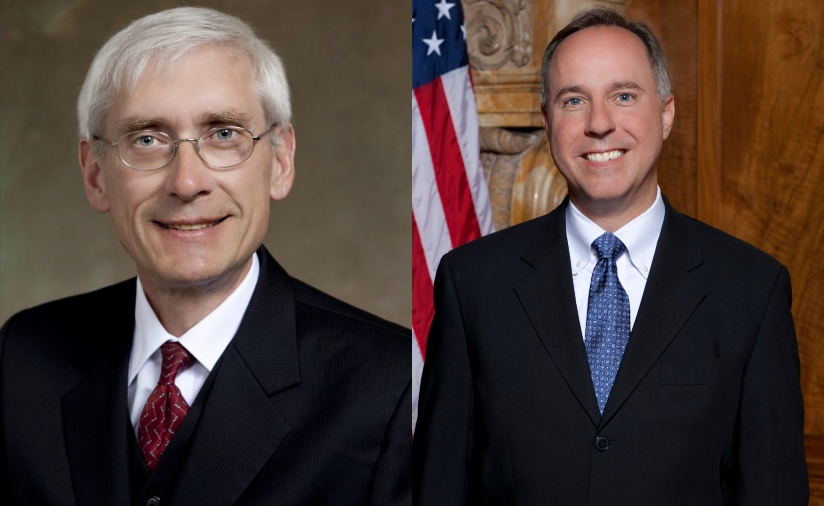Parties Bicker Over How to Do Iowa-Style Redistricting
Democrats charge that Vos plan will hand ultimate power to Republican legislators.
Capitol politicians are full of surprises.
For years, Republican legislative leaders dismissed calls to adopt Iowa’s non-partisan process of redrawing Congressional and legislative district lines. Iowa has professionals draw maps that must then be adopted or rejected by legislators and the governor.
Last week, Wisconsin Assembly Republicans not only proposed a process similar to Iowa’s, but the full Assembly passed it two days later. That Assembly vote – by 63 Republicans and one Democrat – sent it to the Senate, whose Republican leaders have not said whether they will accept it.
In 2019, 52 Democratic legislators sponsored a bill that would have brought Iowa’s non-partisan process for drawing new lines to Wisconsin.
And, on Jan. 27, 2020, Democratic Gov. Tony Evers created a Peoples Maps Commission to draw new district boundaries that lawmakers could adopt. In that order, Evers said “nonpartisan redistricting … must rely on nonpartisan experts for guidance.”
But, last week, Evers dismissed Assembly Republicans’ epiphany on how to draw new district lines as “bogus” and a move “to retain legislative control by having someone Legislature-picked and Legislature-approved draw Wisconsin’s maps.”
“Senate Democrats will not play a part in the charade,” added Senate Democratic Leader Melissa Agard.
Why the reversals? An April election gave liberals a four-justice majority on the state Supreme Court, which could throw out maps drawn by Republican legislators after the 2020 census and order new district lines to be drawn in time for November 2024 elections.
Assembly Speaker Robin Vos announced the Assembly Republicans’ reversal. It came days after Vos said Assembly Republicans might impeach the new justice elected in April, Justice Janet Protasiewicz, if she participates in a likely case responding to a lawsuit challenging current legislative district lines. That threat prompted leaders of the Wisconsin Democratic Party, which gave the Protasiewicz campaign almost $10 million, to target Assembly Republicans who would have to vote to impeach Protasiewicz.
If Wisconsin adopts the Iowa model, Vos said, “There will be no need to have the whole discussion about recusal and millions of dollars of attack ads and special interest trying to buy the election and all the things that we know are coming.”
Vos called Democrats’ opposition to the Iowa model “the height of hypocrisy.”
“I’m a little surprised by the hypocrisy,” said Republican Rep. Todd Novak, who has pushed for the Iowa model. “Some people all of a sudden are opposed to exactly what they’ve been advocating for.”
But Assistant Democratic Leader Kalan Haywood said Republicans “see the ultimate outcome ahead and must distract the people of Wisconsin with another political stunt. Now that you are faced with the potential consequences of your actions, you are trying to change the rules.”
Democrats and Jay Heck, executive director of the nonpartisan Common Cause in Wisconsin, saw a poison pill in Vos’s first plan, since it would have allowed a simple majority of the Republican-controlled Legislature to adopt a third set of maps, if the first two fail to pass the Legislature or are vetoed by the governor.
Responding to that concern, the Assembly added a requirement that a bipartisan vote would be required for any plan to become law. On the final Assembly vote, only Democratic Rep. LaKeshia Myers voted for the bill. But two other Milwaukee Democrats – Marisabel Cabrera and Sylvia Ortiz-Velez – helped pass amendments that moderated the plan and then skipped the final vote.
The Assembly-passed plan would require non-partisan professionals working for the Legislative Reference Bureau (LRB) to draw up new legislative district lines that give no advantage to either party and do not favor incumbents by Jan. 31.
Like the Iowa model, a five-member advisory commission would oversee the process – two Democrats and two Republicans who would choose the fifth member.
The first two sets of LRB maps could not be amended by the Legislature. But, if the first two sets do not pass the Legislature or are vetoed by the governor, a third plan could be amended but only if at least one minority-party legislator voted for the final plan.
Democrats argued that any amendments to a third plan should require a three-fourths majority to be accepted, which is what the Democratic bill in 2021 stipulated. Republicans refused that request.
The absence of a provision requiring a three-fourths majority is one reason why the version of the bill in the Senate “doesn’t go far enough,” said Debra Cronmiller of the nonpartisan League of Women Voters of Wisconsin.
“This bill, if enacted, could result in more of the same extremely gerrymandered Legislative maps that we have now,” Cronmiller said in a statement. “This bill needs to require a supermajority (or 3/4 vote) of the Legislature, to ensure one party does not overrule the process.”
The process has worked in Iowa. In 1981, that state’s Legislative Services Agency’s third set of maps became law; in 1991, the first plan was accepted; in 2001, the second plan was accepted and, in 2021, the second plan was signed into law.
But Iowa’s Legislative Services Agency adds this warning to states like Wisconsin considering its process: “The redrawing of congressional and legislative district boundaries following each decennial census is a difficult process, fraught with many critical legal and political considerations.”
Steven Walters started covering the Capitol in 1988. Contact him at stevenscotwalters@gmail.com
If you think stories like this are important, become a member of Urban Milwaukee and help support real, independent journalism. Plus you get some cool added benefits.
More about the Gerrymandering of Legislative Districts
- Without Gerrymander, Democrats Flip 14 Legislative Seats - Jack Kelly, Hallie Claflin and Matthew DeFour - Nov 8th, 2024
- Op Ed: Democrats Optimistic About New Voting Maps - Ruth Conniff - Feb 27th, 2024
- The State of Politics: Parties Seek New Candidates in New Districts - Steven Walters - Feb 26th, 2024
- Rep. Myers Issues Statement Regarding Fair Legislative Maps - State Rep. LaKeshia Myers - Feb 19th, 2024
- Statement on Legislative Maps Being Signed into Law - Wisconsin Assembly Speaker Robin Vos - Feb 19th, 2024
- Pocan Reacts to Newly Signed Wisconsin Legislative Maps - U.S. Rep. Mark Pocan - Feb 19th, 2024
- Evers Signs Legislative Maps Into Law, Ending Court Fight - Rich Kremer - Feb 19th, 2024
- Senator Hesselbein Statement: After More than a Decade of Political Gerrymanders, Fair Maps are Signed into Law in Wisconsin - State Senate Democratic Leader Dianne Hesselbein - Feb 19th, 2024
- Wisconsin Democrats on Enactment of New Legislative Maps - Democratic Party of Wisconsin - Feb 19th, 2024
- Governor Evers Signs New Legislative Maps to Replace Unconstitutional GOP Maps - A Better Wisconsin Together - Feb 19th, 2024
Read more about Gerrymandering of Legislative Districts here
The State of Politics
-
A Wisconsin Political Trivia Quiz
 Dec 15th, 2025 by Steven Walters
Dec 15th, 2025 by Steven Walters
-
The Fight Over Wisconsin’s House Districts
 Dec 8th, 2025 by Steven Walters
Dec 8th, 2025 by Steven Walters
-
The Battle Over On-Line Betting
 Nov 24th, 2025 by Steven Walters
Nov 24th, 2025 by Steven Walters



















